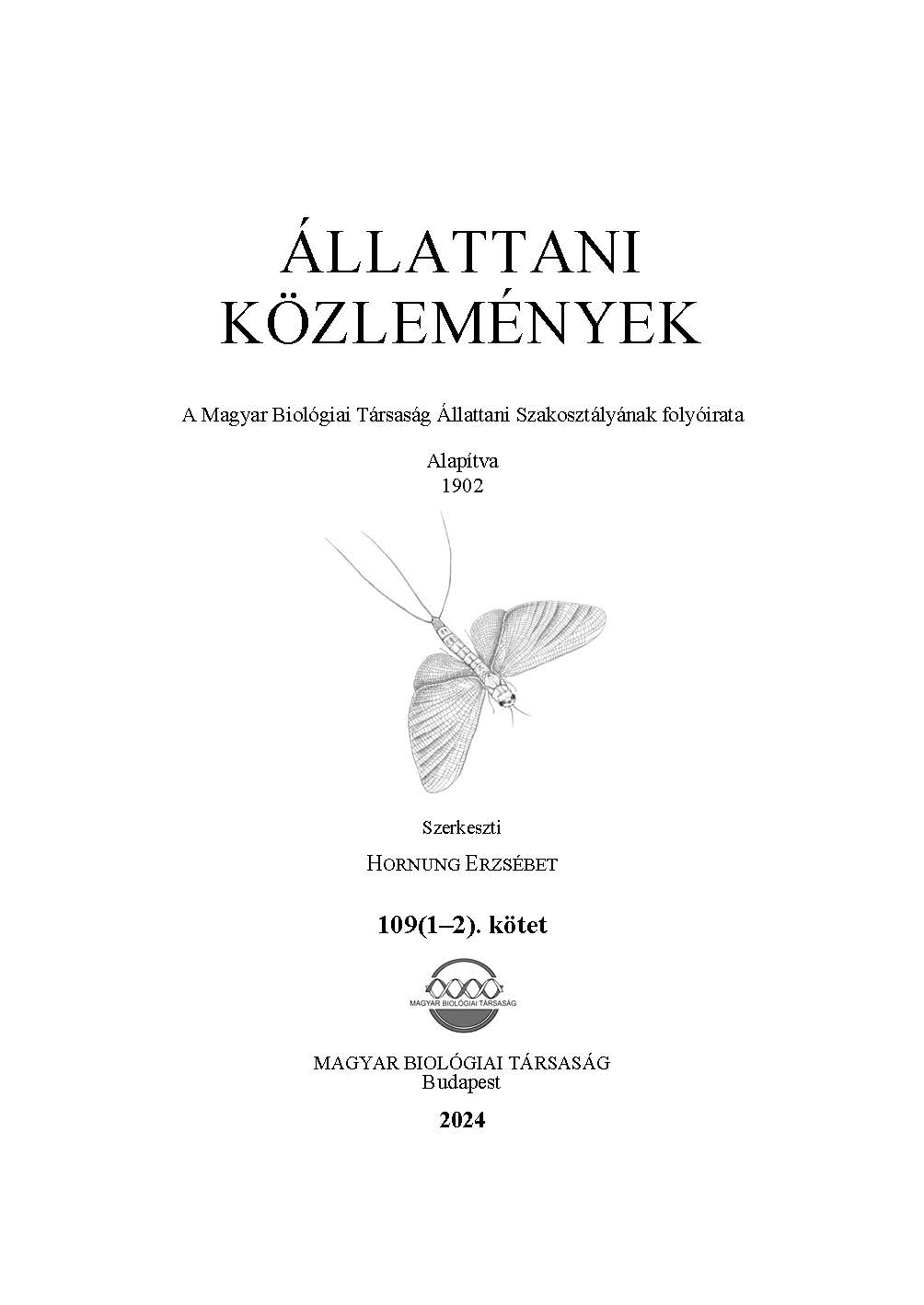Az erdők bogarai: élőhelyváltozások hosszútávú hatásai futóbogár-együttesek szerkezetére, a közösségi szinttől az egyedi viselkedésig
Absztrakt
Egy hosszútávú vizsgálatban (2014–2018) arra kerestem választ, hogy négyféle erdészeti kezelés [kezeletlen kontroll állományhoz viszonyítva: vágásterület, hagyásfacsoport, egyenletes bontás (vágásos üzemmód elemei), valamint lékvágás (örökerdő üzemmód beavatkozása)] hogyan hatnak a futóbogár-együttesek (Coleoptera: Carabidae) szerkezetére a fajalapú és funkcionális diverzitási metrikák alapján. A kutatásokat kiegészítettem az egyedi mozgásmintázatok nyomon követésével is, amivel az élőhelyhasználat viselkedési aspektusára kerestem választ. Igazoltam, hogy az erdei specialista futóbogár-közösség funkcionális redundanciája jól jellemzi az erdőállományok természetességét, továbbá ez a csoport érzékenyen reagál a lombkorona-záródásban bekövetkező változásokra is. Ez a megközelítés segíthet kijelölni olyan erdészeti fahasználatokat, amelyek hozzájárulhatnak a fenntartható erdőgazdálkodáshoz.
Hivatkozások
BAUHUS J., PUETTMANN K., MESSIER C. 2009. Silviculture for old-growth attributes. Forest Ecology and Management, 258: 525–537. https://doi.org/10.1016/j.foreco.2009.01.053
BENGTSSON J., NILSSON S.G., FRANC A. & MENOZZI P 2000. Biodiversity, disturbances, ecosystem function and management of European forests. Forest Ecology and Management, 132: 39–50. https://doi.org/10.1016/S0378-1127(00)00378-9
CADOTTE M., ALBERT C.H. & WALKER S.C. 2013. The ecology of differences: Assessing community assembly with trait and evolutionary distances. Ecology Letters, 16: 1234–1244. https://doi.org/10.1111/ele.12161
CHRISTENSEN M. & EMBORG J. 1996. Biodiversity in natural versus managed forest in Denmark. Forest Ecology and Management, 85: 47–51. https://doi.org/10.1016/S0378-1127(96)03749-8
DESENDER K., ERVYNCK A. & TACK G. 1999. Beetles diversity and historical ecology of woodlands in the Flanders. Belgian Journal of Zoology, 129: 139–156.
DUFRÊNE M. & LEGENDRE P. 1997. Species assemblages and indicator species: the need for a flexible asymmetrical approach. Ecological Monographs, 67: 345–366. https://doi.org/10.1890/0012-9615(1997)067[0345:SAAIST]2.0.CO;2
ELEK Z., DAUFFY-RICHARD E. & GOSSELIN F. 2010. Carabid species responses to hybrid poplar planta-tions in floodplains in France. Forest Ecology and Management, 260: 1446–1455. https://doi.org/10.1016/j.foreco.2010.07.034
ELEK Z., RŮŽIČKOVÁ J. & ÓDOR P. 2021. Individual decisions drive the changes in movement patterns of ground beetles between forestry management types. Biologia, 76: 3287–3296. https://doi.org/10.1007/s11756-021-00805-x
ELEK Z., RŮŽIČKOVÁ J. & ÓDOR P. 2022. Functional plasticity of carabids can presume better the chang-es in community composition than taxon-based descriptors. Ecological Applications, 32(1): 1–13. https://doi.org/10.1002/eap.2460
EUROPEAN COMMISSION 2021. New EU Forest Strategy for 2030. Communication from the Commis-sion to the European Parlament, the Council, the European Economic and Social Committee and the Committee of the Regions, New EU Forest Strategy for 2030: https://eur-lex.europa.eu/legal-content/EN/TXT/?uri=CELEX:52021DC0572 (last access: 25/05/2022).
FYFE R.M., WOODBRIGDE J. & ROBERTS N. 2015. From Forest to Farmland: pollen-inferred land cover change across Europe using the pseudobiomization. Global Change Biology, 21: 1977–1212. https://doi.org/10.1111/gcb.12776
GRÜM L. 1971a. Remarks on the differentiation in Carabidae mobility. Ekologia Polska, 19: 47–56.
GRÜM L. 1971b. Spatial differentiation of the Carabus L. (Carabidae, Coleoptera) mobility. Ekologia Polska, 19: 1–34.
HEIKKALA O., SEIBOLD S., KOIVULA M., MARTIKAINEN P., MÜLLER J., THORN S. & KOUKI J. 2016. Re-tention forestry and prescribed burning result in functionally different saproxylic beetle assemblages than clear-cutting. Forest Ecology and Management, 359: 51–58.
https://doi.org/10.1016/j.foreco.2015.09.043
HERMY M. & VERHEYEN K. 2007. Legacies of the past in the present-day forest biodiversity: a review of past land-use effects on forest plant species composition and diversity. In: NAKASHIZUKA T. (ed.): Sustainability and Diversity of Forest Ecosystems. Tokyo: Springer, pp. 361–371. https://doi.org/10.1007/978-4-431-73238-9_1
KOIVULA M.J., VENN S., HAKOLA P. & NIEMELÄ J. 2019. Responses of boreal ground beetles (Coleo-ptera, Carabidae) to different logging regimes ten years post harvest. Forest Ecology and Manage-ment, 436: 27–38. https://doi.org/10.1016/j.foreco.2018.12.047
LANGROCK R., KING R., MATTHIOPOULOS J., THOMAS L., FORTIN D. & MORALES J.M. 2012. Flexible and practical modeling of animal telemetry data: Hidden Markov models and extensions. Ecology, 93: 2336–2342. https://doi.org/10.1890/11-2241.1
LINDENMAYER D.B., LIKENS G.E., ANDERSEN A., BOWMAN D., BULL C.M., BURNS E., DICKMAN C.R., HOFFMANN A.A., KEITH D.A., LIDDELL M.J., LOWE A.J., METCALFE D.J., PHINN S.R., RUSSELL-SMITH J., THURGATE N. & WARDLE G.M. 2012. Value of long-term ecological studies. Austral Ecology, 37: 745–757. https://doi.org/10.1111/j.1442-9993.2011.02351.x
LÖVEI G.L. & SUNDERLAND K.D. 1996. Ecology and behaviour of ground beetles (Coleoptera: Cara-bidae). Annual Review of Entomology, 41: 231–256. https://doi.org/10.1146/annurev.en.41.010196.001311
MAGURA T. 2017. Ignoring functional and phylogenetic features masks the edge influence on ground beetle diversity across forest-grassland gradient. Forest Ecology and Management, 384: 371–377. https://doi.org/10.1016/j.foreco.2016.10.056
MAGURA T. & LÖVEI G.L. 2019. Environmental filtering is the main assembly rule of ground beetles in the forest and its edge but not in the adjacent grassland. Insect Science, 26: 154–163. https://doi.org/10.1111/1744-7917.12504
MORI A.S. & KITAGAWA R. 2014. Retention forestry as a major paradigm for safeguarding forest biodi-versity in productive landscapes: A global meta-analysis. Biological Conservation, 175: 65–73. https://doi.org/10.1016/j.biocon.2014.04.016
MURRAY B.D., HOLLAND J.D., SUMMERVILLE K.S., DUNNING J.B., SAUNDERS M.R. & JENKINS M.A. 2017. Functional diversity response to hardwood forest management varies across taxa and spatial scales. Ecological Applications, 27: 1064–1081. https://doi.org/10.1002/eap.1532
NEGRO M., CASALE A., MIGLIORE L., PALESTRINI C. & ROLANDO A. 2008. Habitat use and movement patterns in the endangered ground beetle species, Carabus olympiae (Coleoptera: Carabidae). Euro-pean Journal of Entomology, 105: 105–112. https://doi.org/10.14411/eje.2008.015
NIEMELÄ J., KOIVULA M. & KOTZE D.J. 2007. The effects of forestry on carabid beetles (Coleoptera: Carabidae) in boreal forests. Journal of Insect Conservation, 11: 5–18.
https://doi.org/10.1007/s10841-006-9014-0
NOLTE D., SCHULDT A., GOSSNER M.M., ULRICH W. & ASSMANN T. 2017. Functional traits drive ground beetle community structures in Central European forests: Implications for conservation. Bio-logical Conservation, 213: 5–12. https://doi.org/10.1016/j.biocon.2017.06.038
OKUZAKI Y. 2021. Effects of body size divergence on male mating tactics in the ground beetle Carabus japonicus. Evolution, 75: 2269–2285. https://doi.org/10.1111/evo.14302
PAILLET Y., ARCHAUX F., DU PUY S., BOUGET C., BOULANGER V., DEBAIVE N., GILG O., GOSSELIN F. & GUILBERT E. 2018. The indicator side of tree microhabitats: A multi‐taxon approach based on bats, birds and saproxylic beetles. Journal of Applied Ecology, 55: 2147–2159. https://doi.org/10.1111/1365-2664.13181
POMMERENING A. & MURPHY S. T. 2004. A review of the history, definitions and methods of continu-ous cover forestry with special attention to afforestation and restocking. Forestry, 77: 27–44. https://doi.org/10.1093/forestry/77.1.27
RIECKEN U. & RATHS U. 1996. Use of radio telemetry for studying dispersal and habitat use of Carabus coriaceus L. Annales Zoologici Fennici, 33: 109–116.
RŮŽIČKOVÁ J. & ELEK Z. 2021a. Recording fine-scale movement of ground beetles by two methods: Potentials and methodological pitfalls. Ecology and Evolution, 11: 8562–8572. https://doi.org/10.1002/ece3.7670
RŮŽIČKOVÁ J. & ELEK Z. 2021b. Unequivocal Differences in Predation Pressure on Large Carabid Bee-tles between Forestry Treatments. Diversity, 13: 484. https://doi.org/10.3390/d13100484
RŮŽIČKOVÁ J., SÁNDOR B., SZLÁKVO A. & ELEK Z. 2021. Individual movement of large carabids as a link for activity density patterns in various forestry treatments. Acta Zoologica Academiae Scien-tiarum Hungaricae, 67(1): 77–86. https://doi.org/10.17109/AZH.67.1.77.2021
SAPIA M., LÖVEI G.L. & ELEK Z. 2006. Effects of varying sampling effort on the observed diversity of carabid (Coleoptera: Carabidae) assemblages in the Danglobe Project, Denmark. Entomologica Fennica, 17: 345–350. https://doi.org/10.33338/ef.84356
SCHIRMEL J., BLINDOW I. & BUCHHOLZ S. 2012. Life-history trait and functional diversity patterns of ground beetles and spiders along a coastal heathland successional gradient. Basic and Applied Ecol-ogy, 13: 606–614. https://doi.org/10.1016/j.baae.2012.08.015
THIELE H.U. 1977. Carabid Beetles in Their Environments. New York: Springer. https://doi.org/10.1007/978-3-642-81154-8
VANBERGEN A.J., WOODCOCK B.A., WATT A.D. & NIEMELÄ J. 2005. Effect of land-use heterogeneity on carabid communities at the landscape scale. Ecography, 28: 3–16.
https://doi.org/10.1111/j.0906-7590.2005.03991.x
WOOTTON J.T. 1998. Effects of disturbance on species diversity: a multitrophic perspective. The Ameri-can Naturalist, 152: 803–825. https://doi.org/10.1086/286210
YAMANAKA S., YAMAURA Y., SAYAMA K., SATO S. & OZAKI K. 2021. Effects of dispersed broadleaved and aggregated conifer tree retention on ground beetles in conifer plantations. Forest Ecology and Management, 489: 119073. https://doi.org/10.1016/j.foreco.2021.119073







